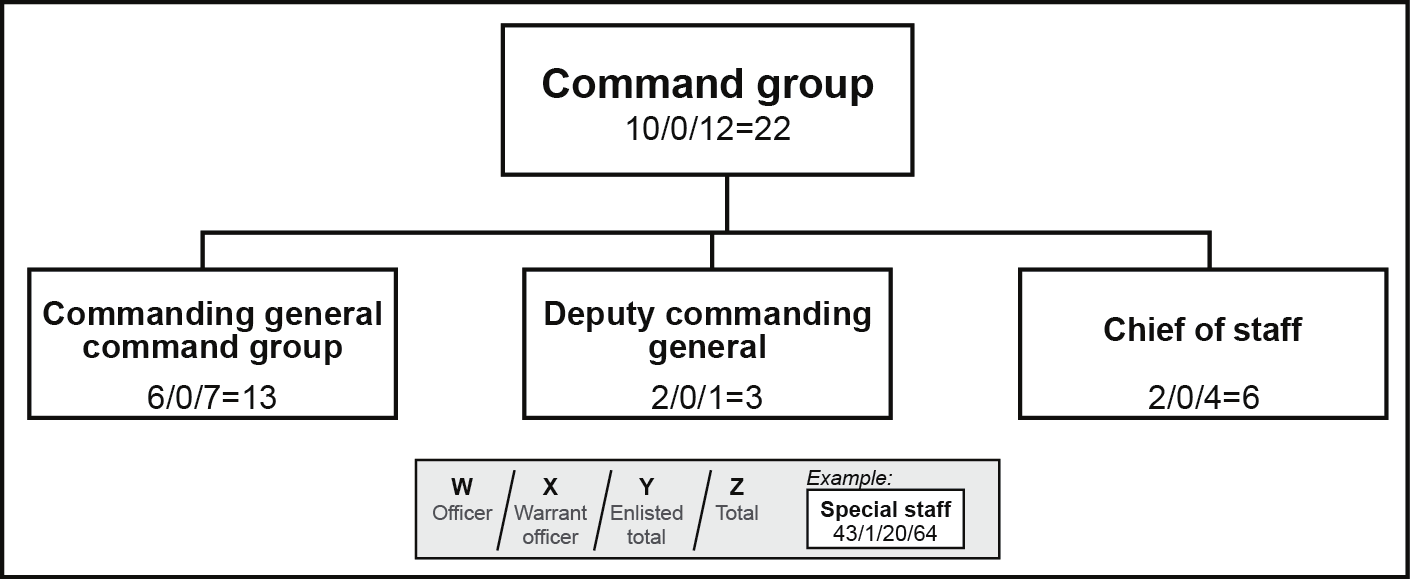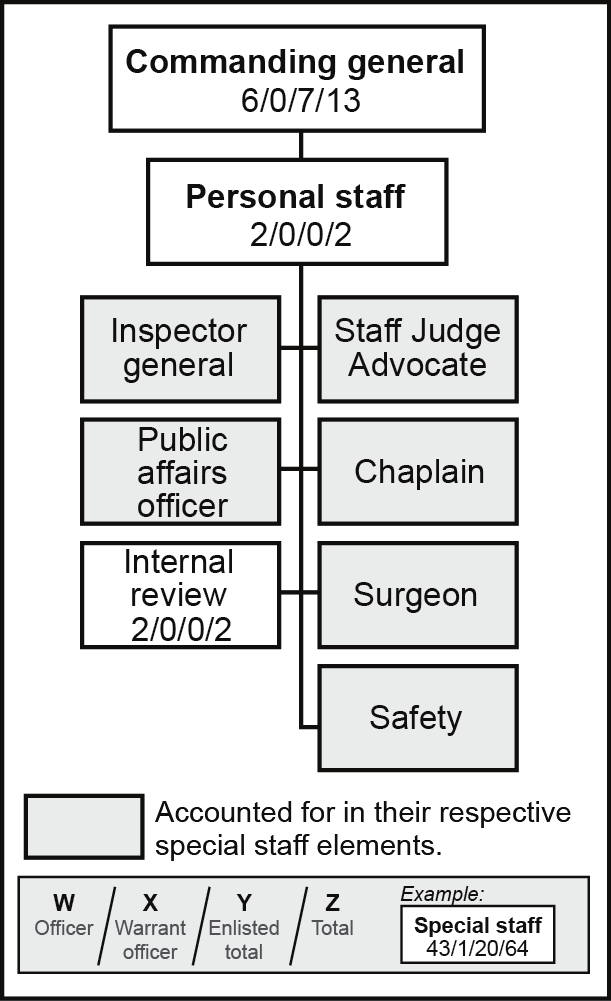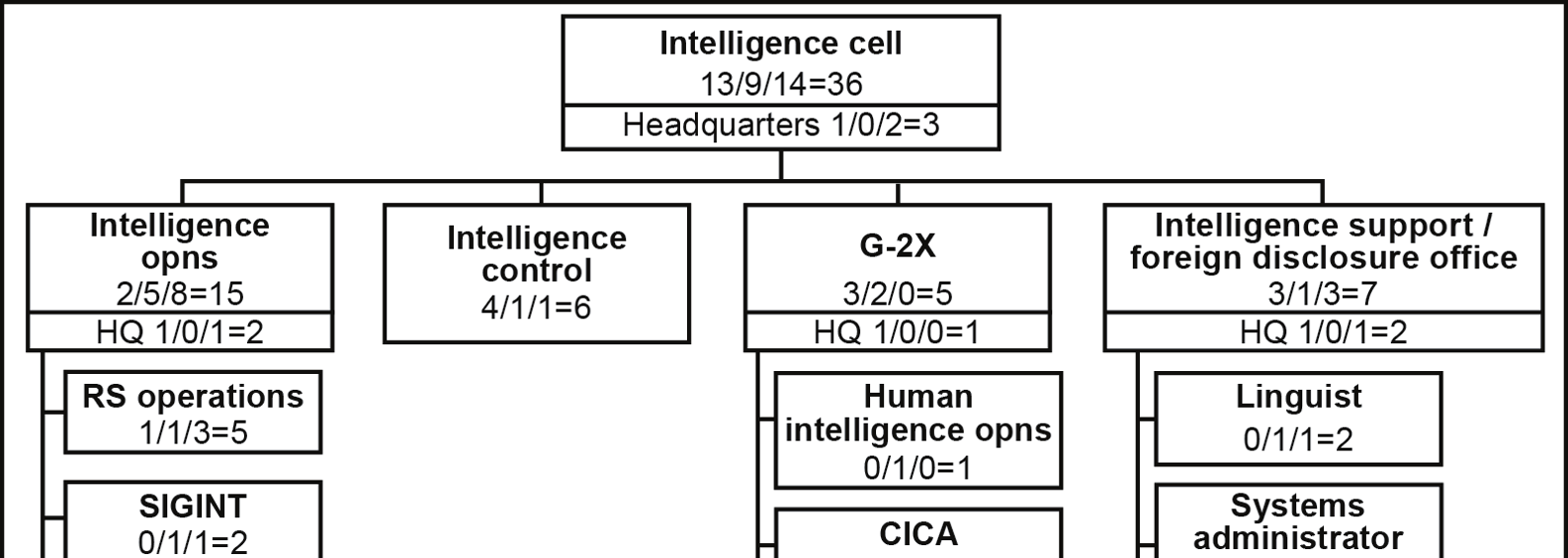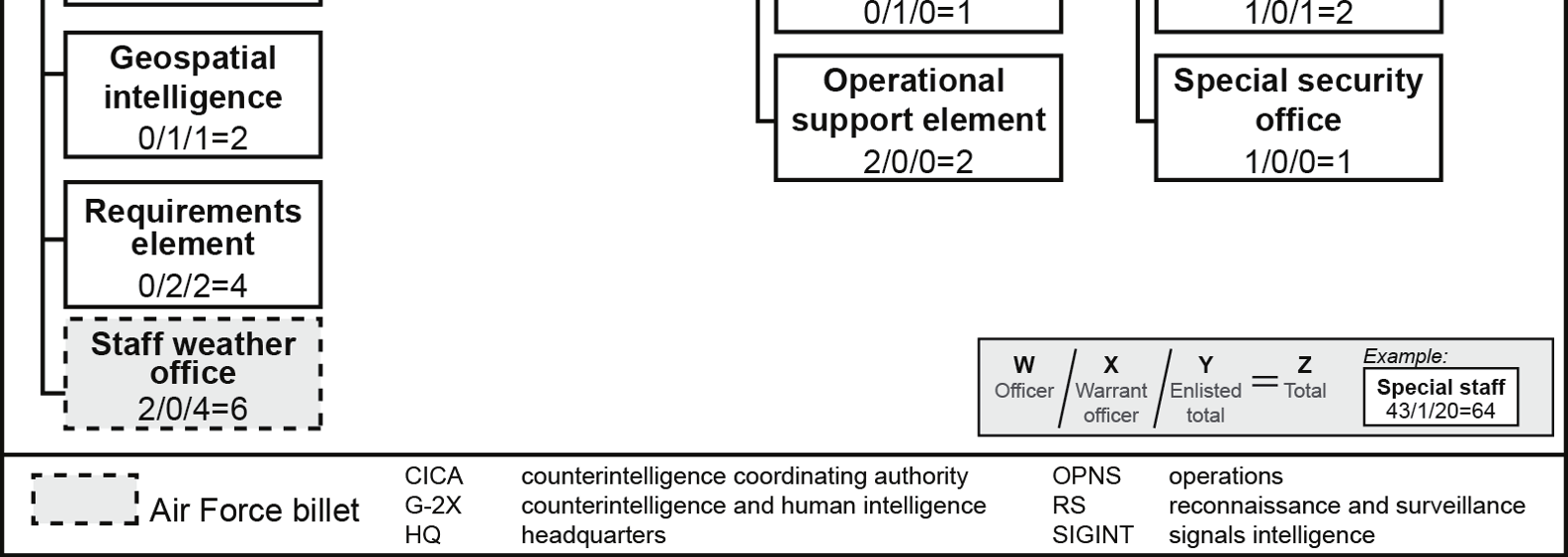This page intentionally left blank.



Chapter 5
Theater Army Headquarters and Headquarters Battalion
5-1. The theater army headquarters and headquarters battalion provides the administrative and sustainment support to the theater army headquarters, to include the contingency command post when it deploys for any operation. The headquarters and headquarters battalion is organized with a commander, command group, a battalion staff (S1, S2, S3, and S4), and three subordinate companies, described in figure 5-1. (This organization is in accordance with design and not the modified table of organization and equipment or the Table of Distribution and Allowance.)
Figure 5-1. Theater army 5.4 headquarters and headquarters battalion organization 5-2. The headquarters support company is designed to deploy with the contingency command post to provide sustainment support and mission command the local security section provided by an outside organization. Theater army personnel assigned to the headquarters support company include the commanding general section, the deputy commanding general section, the personal staff, the chief of staff 12 October 2011
FM 3-93
5-1
Chapter 5
section, the special staff, the headquarters and headquarters battalion headquarters staff, the contingency command post command group, the contingency command post special staff, and the contingency command post support sections.
5-3. The operations company consists of a standard company headquarters element and the personnel of the main and contingency command post cells and sections: movement and maneuver, protection, and mission command (including the G-6).
5-4. The intelligence and sustainment company is composed of a standard company headquarters element and the personnel of the intelligence and sustainment cells of the main and contingency command posts.
5-5. The contingency command post, and the headquarters support company which supports it, are dependent upon the theater army headquarters and headquarters battalion for all administrative control services and Title 10, United States Code support.
5-2
FM 3-93
12 October 2011

Chapter 6
Theater Army Command Group
6-1. The theater army command group is responsible for providing operational direction to Army component forces. It develops and supervises planning, preparation, execution and assessment for a wide range of activities in the geographic combatant commander’s (GCC’s) area of responsibility (AOR). The command group leads the Army operations process (plan, prepare, execute, and assess), while participating in the GCC’s joint operations planning process. The theater army command group consists of the commanding general section, the deputy commanding general command section, and the chief of staff section. Figure 6-1 depicts the theater army 5.4 command group. (This organization is in accordance with design, not the modified table of organization and equipment or the Table of Distribution and Allowance.) Figure 6-1. Theater army 5.4 command group
COMMANDING GENERAL COMMAND GROUP
6-2. Paragraphs 6-3 through 6-5 discuss the mission, organization, and tasks of the commanding general command group.
MISSION
6-3. The commanding general command group provides mission command to the theater army, and it prioritizes the effort for the staff and assigned units.
ORGANIZATION
6-4. The command group consists of the commanding general, the command sergeant major, a science officer, and a political military advisor along with an aide-de-camp, and other associated support personnel.
TASKS
6-5. The commanding general directs planning, policy development, programming, budgeting for theater army Title 10 Army support to other Services, and executive agent responsibilities in the AOR. The commanding general exercises administrative control of all Army forces in the AOR by providing for the administration, support, and protection of all Army forces in the AOR. The commanding general directs, leads, and assesses operations using designated Army, joint, and multinational forces to support GCC
directed missions. The executive officer, aide de camp, and support staff organize and coordinate 12 October 2011
FM 3-93
6-1
Chapter 6
scheduling, activities, travel, staff actions, and logistics support to the commanding general. The command sergeant major enforces policy and standards for performance, training, appearance, and conduct of Army enlisted personnel in the AOR. The political advisor provides perspectives and policy positions on political issues for the commanding general. The science advisor provides analysis and advice on research and development efforts affecting future planning and provides potential materiel solutions to capability gaps.
The communications team installs, operates, maintains, and restores assigned equipment in support of the commanding general.
DEPUTY COMMANDING GENERAL
6-6. Paragraphs 6-7 through 6-9 discuss the mission, organization, and tasks of the deputy commanding general.
MISSION
6-7. The deputy commanding general serves as second in command of the theater army and extends the control of the commanding general in designated areas to include commanding the contingency command post when deployed.
ORGANIZATION
6-8. The deputy commanding general section consists of the deputy commanding general, the aide de camp, and the driver and communications specialist. The section deploys with the contingency command post, if so directed by the commanding general.
TASKS
6-9. The deputy commanding general assists in the planning, policy development, programming, and budgeting for theater army Title 10 Army support to other Services and executive agent responsibilities in the AOR. The deputy commanding general assists the commanding general in exercising administrative control of all Army forces in the AOR, and assists the commanding general in driving the operations process. When directed, the deputy commanding general assists in directing, leading, and assessing operations using designated Army, joint, and multinational forces to support GCC directed missions. The deputy commanding general executes his responsibilities from the main command post or, if directed, from the contingency command post. His aide de camp and driver and communications specialist organize and coordinate scheduling, activities, travel, staff actions, and logistics support for the deputy commanding general.
CHIEF OF STAFF
6-10. Paragraphs 6-11 through 6-13 discuss the mission, organization, and tasks of the chief of staff.
MISSION
6-11. The chief of staff serves as the commanding general’s principal assistant for coordinating and training the staff and establishing and managing the command post.
ORGANIZATION
6-12. The chief of staff office consists of a secretary of the general staff and executive services section, which consists of one officer, and a staff action section, which consists of four noncommissioned officers.
6-2
FM 3-93
12 October 2011
Theater Army Command Group
TASKS
6-13. The chief of staff directs and supervises the contingency command post support functions of the headquarters and headquarters battalion, and the activities of the staff and liaison officers. The chief of staff directs operations of the special staff and the mission command warfighting functional cell. The chief of staff establishes the business rules, workday schedule, and battle rhythm of the headquarters and staff sections. The chief of staff, with the commander’s guidance, may extend or otherwise modify the business rules and battle rhythm of the headquarters in order to support operational requirements. The chief of staff supervises the secretary of the general staff and monitors preparations for conferences, social events, and ceremonies. The chief of staff directs and monitors collective training of the staff. The secretary of the general staff manages staff actions and executive services and monitors support to major conferences. The staff action section processes all staff actions and assists the secretary of the general staff as needed.
12 October 2011
FM 3-93
6-3
This page intentionally left blank.

Chapter 7
Theater Army Personal Staff
7-1. Personal staff members work under the theater army commander’s immediate control as depicted in figure 7-1. However, they also serve as special staff officers when they coordinate with other staff members. When performing their duties as special staff officers, personal staff officers may work through the chief of staff and under a coordinating staff officer for coordination and control purposes. The theater army commander’s personal staff includes the chiefs of the following staff sections: chaplain, inspector general, public affairs, safety, staff judge advocate, surgeon, and the internal review. (This organization is in accordance with design, not the modified table of organization and equipment or the Table of Distribution and Allowance.)
Figure 7-1. Theater army 5.4 personal staff
INTERNAL REVIEW SECTION
7-2. The internal review section develops plans, policies, and reports for the review and audit of the command’s processes and practices to prevent fraud, waste, and abuse of resources. The internal review section consists of a chief and an action officer responsible for performing internal reviews and evaluations.
7-3. The internal review section assists the commander to ensure effective stewardship of the command’s resources and compliance with related laws, policies, and procedures. The section executes reviews, and it consults, advises, and liaisons to assist the commander in improving financial management operations. The section conducts an audit compliance function and serves as the theater army’s point of contact for external audit groups. It reports on the external audit group’s findings and conducts follow-up audits, if required.
12 October 2011
FM 3-93
7-1
This page intentionally left blank.

Chapter 8
Theater Army Special Staff
8-1. The chief of staff directs and synchronizes those special staff sections of the theater army that are not coordinated by the primary coordinating staff officers. The special staff supports the commander and designated staff and subordinate commands. Figure 8-1 depicts the special staff. Many special staff offices also have representatives permanently assigned to one of more of the warfighting functional cells. All send representatives to the six functional cells and three integrating cells to assist in conducting operations as required. The special staff includes command liaison officers, the operational research systems analysis section, knowledge management, inspector general, staff judge advocate, public affairs, chaplain, and red team sections. (This organization is in accordance with design, not the modified table of organization and equipment or the Table of Distribution and Allowance.)
Figure 8-1. Theater army 5.4 special staff
COMMAND LIAISON OFFICER SECTION
8-2. Paragraphs 8-3 through 8-5 discuss the mission, organization, and tasks of the command liaison officer section.
MISSION
8-3. The command liaison officers represent the theater army commander at the receiving headquarters.
The liaison officer section synchronizes coordination between headquarters and relays the commander’s intent and concept for operations.
ORGANIZATION
8-4. The command liaison officer staff section consists of ten officers organized into five, two-man teams.
TASKS
8-5. The command liaison officer section deploys to higher headquarters, Service component commands, host nation agencies, multinational partners, interagency, and nongovernment organizations within the area of responsibility, as directed. The liaison officer teams coordinate and synchronize theater army efforts between commands, and the geographic combatant commander, main command post, and contingency command post staffs, and other joint task force organizations. They assist in coordinating Army support to the joint, interagency, and multinational forces. They advise the gaining headquarters on the capabilities and limitations of Army forces and the most appropriate ways to employ them. The command can request digital liaison officer detachments to provide digital connectivity between the theater army, joint, and multinational forces, if required.
12 October 2011
FM 3-93
8-1
Chapter 8
OPERATIONS RESEARCH AND SYSTEMS ANALYSIS SECTION
8-6. Paragraphs 8-7 through 8-9 discuss the mission, organization, and tasks of the operations research and systems analysis section.
MISSION
8-7. The operations research and systems analysis section provides analytic support to the theater army staff for planning and assessment of operations.
ORGANIZATION
8-8. The operations research and systems analysis section consists of a section chief and two action officers.
TASKS
8-9. The operations research and systems analysis section provides quantitative analytic support, including regression and trend analysis, to theater army planning and assessment activities. The operations research and systems analysis staff assists other staff in developing customized analytical tools for specific requirements, provides a quality control capability, and conducts assessments to measure the effectiveness of operations.
KNOWLEDGE MANAGEMENT SECTION
8-10. Paragraphs 8-11 through 8-13 discuss the mission, organization, and tasks of the knowledge management section.
MISSION
8-11. The theater army knowledge management section supports the commander and staff in achieving situational understanding and making informed, knowledgeable, and timely decisions through the integration and management of Army Battle Command Systems and various other collaboration tools.
ORGANIZATION
8-12. The knowledge management section in the main command post consists of three officers and one noncommissioned officer.
TASKS
8-13. The knowledge management section advises the staff on knowledge management processes and enabling technologies. The section facilitates the creation, collection, organization, storage, application and transfer of knowledge by using innovative technology to facilitate situational understanding and decisionmaking. The section assists the commander and staff in integrating battle command systems into the headquarters processes consistent with knowledge management best practices. The section coordinates with the G-6 (assistant chief of staff, signal) for technical network requirements and analysis of new knowledge management information technology for increased knowledge management capabilities. It assists the staff in managing the common operational picture and briefings. The section performs knowledge management assessments to identify processes to improve information flow across the organization.
INSPECTOR GENERAL SECTION
8-14. Paragraphs 8-15 through 8-17 discuss the mission, organization, and tasks of the inspector general section.
8-2
FM 3-93
12 October 2011
Theater Army Special Staff
MISSION
8-15. The theater army inspector general section acts as an extension of the commander’s eyes, ears, voice, and conscience while conducting inspections, assistance actions, and investigations for all Army forces under the commander’s administrative control that lack organic inspector general support.
ORGANIZATION
8-16. The theater army inspector general section consists of six officers and eight noncommissioned officers.
TASKS
8-17. The command inspector general is the local proponent and advisor on Army inspection policy as outlined in AR 1-201. The command inspector general serves as personal staff to the theater army commander. The section performs all four inspector general functions: inspections, assistance, investigations, and teaching and training. The inspector general staff provides services to all Army forces in the area of responsibility that lack organic inspector general support. The section augments the contingency command post operations based on mission requirements.
STAFF JUDGE ADVOCATE SECTION
8-18. Paragraphs 8-19 through 8-21 discuss the mission, organization, and tasks of the staff judge advocate section.
MISSION
8-19. The staff judge advocate section serves as the principal legal advisor to the commander, staff, and subordinate organizations.
ORGANIZATION
8-20. The stuff judge advocate section consists of ten officers, one warrant officer, and five noncommissioned officers.
TASKS
8-21. The section advises the commander and staff on all matters pertaining to law, policy, regulation, and good order and discipline in the area of operations. The staff judge advocate section participates in the operations process, military decisionmaking planning process, and other subordinate process. The section allocates its subordinates between participating in theater army planning sessions, preparing or participating in boards, bureaus, centers, cells, and working groups, and supporting the contingency command post when deployed. The international and operational law division provides legal advice and support regarding the application of international law and agreements, U.S. law, customs, and activities affecting military operations. The military justice division provides legal advice and support for the administration of the Uniform Code of Military Justice. The chief of claims provides legal advice and support for the investigation, processing, adjudication, and settlement of claims on behalf of and against the United States worldwide. The chief of legal assistance provides personal civil legal services to eligible personnel. The administrative and civil law division provides legal advice and support for the establishment, command, and functioning of military organizations, installations, and related military and civil authorities. The contract and fiscal law division provides legal advice and support for the application of domestic statutes and regulations related to the funding of military operations and support to nonfederal agencies and organizations.
12 October 2011
FM 3-93
8-3
Chapter 8
PUBLIC AFFAIRS SECTION
8-22. Paragraphs 8-23 through 8-25 discuss the mission, organization, and tasks of the public affairs section.
MISSION
8-23. The theater army public affairs section advises the commander and expedites the flow of accurate and timely information about the activities of U.S. Army and U.S. joint forces to external population and internal audiences.
ORGANIZATION
8-24. The public affairs section consists of four officers and four noncommissioned officers. The public affairs staff section executes two primary functions: media operations and public affairs plans and operations.
TASKS
8-25. The public affairs section advises the commander and staff on all aspects of public affairs planning, information strategies, media facilitation, and training. The section provides advice on community relations issues and operations. The section provides advice on the use of command information print and broadcast (radio or television) capabilities. The public affairs officer coordinates public affairs planning and operations, media facilitation, and nongovernmental organization requests with subordinate, adjacent and higher headquarters as required. The section responds to media queries, and it plans and coordinates media visits and media embed requests. A public affairs operations center and a mobile public affairs detachment must augment the public affairs section to establish a media center and conduct wartime or crisis public affairs operations.
CHAPLAIN SECTION
8-26. Paragraphs 8-27 through 8-29 discuss the mission, organization, and tasks of the chaplain section.
MISSION
8-27. The command chaplain provides staff supervision over all Army religious support operations in the theater and advises the command on the religious dynamics within the operational area.
ORGANIZATION
8-28. The command chaplain section consists of three officers and two noncommissioned officers. The command chaplain is a personal staff officer to the theater army commander. The section consists of the command chaplain, a senior chaplain assistant, an operations and training element, and a world religions staff element.
TASKS
8-29. The command chaplain and senior chaplain assistant provide the commander with pastoral care, personal counseling, and confidential communications, and they recommend religious support policy for the command. The command chaplain section plans, coordinates, and supervises religious support and policy for the area of operations. It advises the commander and staff on all religious, moral, and morale matters within the command. It ensures that policies and leadership practices of the command are in keeping with the highest moral, ethical, and humanitarian standards. The section develops and integrates religious support into training events and exercises. The section conducts continuous tactical, operational, and strategic world religions analysis and training. It provides guidance on the conduct of religious leader liaison missions, and advises the command and staff on regional religions (including sites, traditions, and customs).
8-4
FM 3-93
12 October 2011
Theater Army Special Staff
RED TEAM SECTION
8-30. Paragraphs 8-31 through 8-33 discuss the mission, organization, and tasks of the red team section.
MISSION
8-31. The red team section provides the commander an independent capability to explore alternatives in plans, operations, concepts, organizations, and capabilities in the context of the operational environment from the perspectives of adversaries, partners, and others.
ORGANIZATION
8-32. The red team consists of four officers. A regional foreign area officer augments the team, and the military intelligence brigade supports it.
TASKS
8-33. The red team supports decisionmaking by providing assistance in problem framing, challenging assumptions, and providing alternatives during planning and operations. The red team assists in identifying friendly and enemy vulnerabilities and opportunities, and it uses assessment tools to gauge progress. The red team anticipates cultural perceptions of partners, adversaries, and others in planning and operations.
The red team conducts critical reviews of theater army estimates, plans, and orders. The team attends appropriate boards, cells, centers, and working groups. The red team primarily interacts with the planning group at the main command post in each phase of the military decisionmaking process for campaign design. During execution of operations, the red team identifies the impacts and potential consequences (including second or third order effects) of proposed or ongoing actions.
12 October 2011
FM 3-93
8-5
This page intentionally left blank.


Chapter 9
Theater Army Intelligence Cell
9-1. The theater army intelligence cell is responsible for the synchronization and integration of intelligence operations throughout the area of operations (AO). The cell's sections and elements either embed or coordinate with the staff to facilitate this synchronization. Specifically, the cell conducts policy formulation, planning, programming, budgeting, management, force integration, evaluation, and oversight of all intelligence activities. It provides functional oversight of assigned or attached intelligence personnel and units. It manages theater intelligence collection, production, dissemination, disclosure, and counterintelligence requirements. The cell coordinates for national intelligence support and executes intelligence engagement and theater security cooperation as required. The intelligence cell is dependent on the theater military intelligence brigade for intelligence collection, single source analysis, and all source fusion to meet the theater army’s intelligence needs. Figure 9-1 depicts the theater army intelligence cell.
(This organization is in accordance with the design, not the modified table of organization and equipment or the Table of Distribution and Allowance.)
Figure 9-1. Theater army 5.4 intelligence cell
INTELLIGENCE CELL HEADQUARTERS ELEMENT
9-2. Paragraphs 9-3 through 9-5 discuss the mission, organization, and tasks of the intelligence cell headquarters element.
12 October 2011
FM 3-93
9-1
Chapter 9
MISSION
9-3. The intelligence cell headquarters element provides management, direction, and priorities to the cell and provides information and recommendations to the theater army commander.
ORGANIZATION
9-4. The intelligence cell headquarters element consists of an intelligence staff officer (G-2), an intelligence sergeant major, and an intelligence analyst.
TASKS
9-5. The intelligence cell headquarters element develops policy, planning, staff supervision, force integration, evaluation, and oversight for intelligence activities. The element determines and











